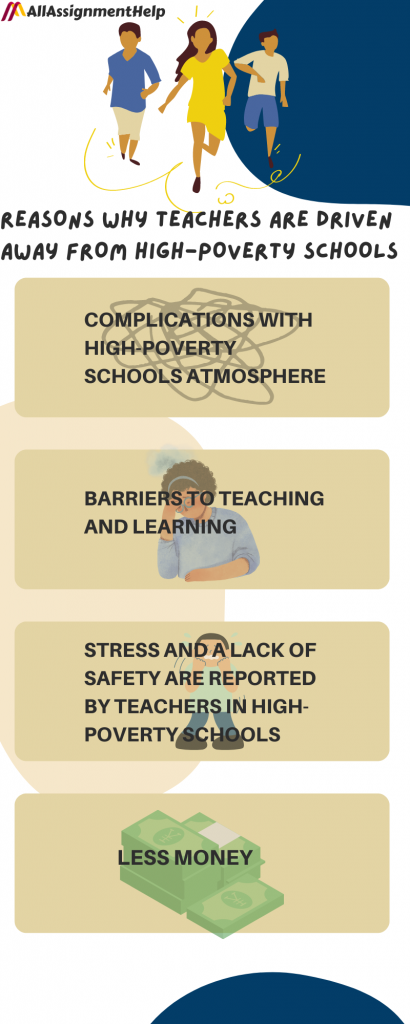Table of Contents
One of the most significant issues with modern American education is the failure to guarantee education-related things. These especially those in underprivileged schools are staffed with qualified teachers. Now the question that arises is, What problem causes these issues? Well, it is mostly caused by teacher shortages in high-poverty schools. This, in turn, is primarily caused by recent increases in student enrollment and teacher retirement. It’s happening particularly in those in metropolitan areas, which wind up with a large proportion of underqualified instructors. Why? Because, they are unable to compete for the supply of accessible, well-prepared teachers. The latter is in turn believed to be the main reason why children from underprivileged neighbourhoods have worse than favourable educational and occupational outcomes.
Furthermore, it makes sense that the current policy response to these staffing issues in schools has been an effort to boost the supply of teachers. Many different programmes have been put into place recently to attract fresh candidates to teaching, particularly in underprivileged situations.
Well! make yourself all ears and put up your reading mode on as this blog by allassignmenthelp.com will tell you all about this topic.
How Can You Define High-Poverty Schools?
The US has extremely high educational standards. And, many students are receiving a top-notch education at numerous institutions across the natioseveral aspects posets that pose some concerns. One of which is the teachers’ disinterest in working in high-poverty schools. This prevents students from learning from seasoned teachers. Therefore, it also has a negative impact on their academic performance in a number of ways.
Now let’s get to the definition.
- A school is considered to have a high level of poverty if at least 70% of its students qualify for free or reduced-price meals.
- This comes under the Richard B. Russell National School Lunch Act.
- Also if at least 70% of its students come from low-income families.
- This is therefore in accordance with one of the standards outlined in section 1113(a)(5) of the ESEA.
- Eligibility for middle and high schools may be determined using comparable data from feeder schools.
People naturally seek an easy existence, whether at home or at work. Why? Because they perform better in a comfortable atmosphere than in a challenging one. Teachers pursue the same goals. It is common knowledge that education has changed from the days when educators made an attempt to educate students without considering their welfare. Most instructors today choose to work at institutions with superior working environments in terms of amenities and social conditions. Simply put, tutors choose lower-poverty schools because they have access to the most up-to-date and plentiful materials there. Therefore, this makes it easier for them to teach and allows them to pick up new skills.
Reasons Why Teachers are Driven Away From High-Poverty Schools

Teachers are drawn to the principal’s leadership, colleagues’ encouragement, and the chance to work with seasoned experts. Well! they don’t receive everything when working in a high-poverty school. Therefore, teachers appear to be acting morally by preferring to teach in those institutions. Although it may be unethical. Instructors cannot be the sole ones getting flak from all sides. Both governments and school administration must carry out their duties. They must provide improved working conditions for the tutors in order for them to feel at ease instructing in high-poverty schools. And, for the pupils to benefit from learning from qualified professionals and achieving their academic goals.
Following are some reasons to be kept in mind which are driving away teachers from these institutions:
Complications with High-Poverty Schools Atmosphere
- The atmosphere has a big impact on employees and their willingness to stick with their current jobs.
- Therefore, the problem of school climate affects all students and contributes to the teacher shortage.
- Teachers experience obstacles to learning.
- They also sometimes feel threats to their safety.
- And, even a lack of voice and influence over decisions about school policy and a lack of autonomy in the classroom affects teachers.
The majority of the elements that collectively make up a school’s atmosphere are influenced by more powerful societal pressures. And this, therefore, includes increased poverty, the continued racial and economic segregation of schools, and a lack of adequate public funding.
Also Read: Achieving Teaching Grants To Become Productive Teacher
Barriers to Teaching and Learning
- Another important reason that drove away teachers from high-poverty schools is the barriers to teaching and understanding.
- There are certain circumstances that create these barriers.
- These conditions include conduct and elements including student tardiness and absenteeism.
- One reason is also that the parents struggle to be involved in their kids’ schools.
- Student disengagement also results in problems among teachers.
- Poor student health and inadequate student preparedness for instruction also create a wall between students and teachers.
- Also, students are not prepared to learn, arrive at school and engage in class-cutting.
Stress and a Lack of Safety Are Reported by Teachers in High-Poverty Schools
- Physical safety, emotional and mental well-being and mental well-being of teachers at work are really important.
- Instructors overall claim the strain and setbacks of teaching.
- The fact is that more than one in five teachers and one in eight report having been physically attacked by a pupil at their current school. This, therefore, raises serious concerns.
- Without debate, these factors influence the working environment and conditions.
- And, can cause shortages by detracting from the appeal of the profession.
Less Money
- Money is the main area of concern for every youth out there.
- As these high-poverty schools are not good in money, this is also a reason that teachers run away from them.
- The fancy institutions offer many facilities plus they are good at giving out money.
- Therefore, instructors often get attracted to them.
WELL WELL WELL! These are the reasons why teachers have literally been driven away from high-poverty schools. However, teaching is an ideal career. Now the question that blinks is how can these issues be resolved. Education is is something that is really very important in every person’s life. Our future depends on our educations so it is important for every sector to be implanted with knowledge. Let’s figure out some ways.
How Can These High-Poverty Schools Be Reshaped?
Always remember that every problem comes with a solution. There is no such thing as “this can’t be sorted out”. Similarly the issue of no popularity of such high-poverty schools among teachers can be resolved. It can be reshaped if various changes can be induced.
I have discussed them below in heads for a better understanding.
Opinion and Control Teachers Have In Their Schools and Daily Work
- Teachers having a sense of purpose and having a say in the working circumstances and policies of their institution make them feel important.
- If their opinion is being considered in the working place, it will eventually make them stay.
- Therefore, the more they have say in the school the more they will love teaching there.
Making Poor School Atmosphere Depression Free For Teachers
- Given the difficult working conditions in many schools, it is not surprising that teachers’ are driven away.
- Their happiness, motivation, and willingness to remain in the profession are poor.
- Theirfore, they also have even somewhat decreased over the previous several years.
- If the teachers are motivated and engaged then this will effect the atmosphere positively.
- Any activity that can help in decreasing the depression level in the school will help in reshaping the high-poverty schools.
Also Read: Education: A Once-In-A-Lifetime Opportunity to Achieve Success
Shorting Out the Difficulty in Recruiting and Keeping Teachers
- The first thing that can be done is making teaching desirable for instructors by increasing salary and avoid giving poor salary.
- Giving excessive moonlighting to supplement wages with profession-building activities.
- Making the environment less challenging for them.
- Working on physical and mental stress given to teachers in the high-poverty schools
In a Nutshell!
What do we know about schools as places where teachers work? When considered collectively, these findings imply that in order to guarantee that all students have access to excellent teachers, all schools must develop into settings where teachers can work. And, students can study in a well planned atmosphere that supports them. This lesson gives us a place to start, but there is still a lot to learn.
Determining the causes of the considerable exodus of teachers from high-poverty schools and what may be done to retain them is, therefore, vital for education specialists. This brief overview of the reasons why instructors don’t want to work in high-poverty schools is now at an end. I hope it can be useful to you in some way. If you want more blogs that will educate you, keep coming back to our website.
We are an online assignment assistance company US that helps students from the Unites States and many other nations with their assignments. Our team of assignment professionals at our organisation is made up of highly qualified individuals. They are capable of producing an excellent project while considering the requirements of your university. Therefore, if you are having trouble completing an assignment, visit our website and use our assignment help online to get it completed by experts.
Frequently Asked Questions
| Question- What are high-poverty schools? Answer- A school is considered to have a high level of poverty if at least 70% of its students qualify for free or reduced-price meals. Also if at least 70% of its students come from low-income families. |
| Question- What are the main reasons that drove away the teachers from these high-poverty schools? Answer- The main reasons are: 1. Complications with High-Poverty Schools Atmosphere. 2. Barriers to Teaching and Learning. 3. Stress and a Lack of Safety Are Reported by Teachers in High-Poverty Schools. 4. Not Much Money |
